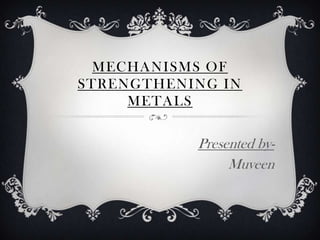
Mechanisms of strengthening in metals
- 1. MECHANISMS OF STRENGTHENING IN METALS Presented by- Muveen
- 2. Abstract- The understanding of the strengthening mechanisms is crucial both in the development of new materials with improved mechanical properties and in the development of better material models in the simulation of industrial processes. Three different mechanisms namely, solid solution strengthening, grain size strengthening and strain hardening have been examined in detail.
- 3. The size of the grains, or average grain diameter, in a polycrystalline metal influences the mechanical properties. Adjacent grains normally have different crystallographic orientations and, of course, a common grain boundary. The grain boundary acts as a barrier to dislocation motion for two reasons: 1. Because the two grains are of different orientations, a dislocation passing into grain B will have to change its direction of motion; this becomes more difficult as the crystallographic disorientation increases. 2. The atomic disorder within a grain boundary region will result in a discontinuity of slip planes from one grain into the other. A fine-grained material (one that has small grains) is harder and stronger than one that is coarse grained, because the former has a greater total grain boundary area to impede dislocation motion.
- 4. For many materials, the yield strength σy varies with grain size according to σy = σ0 + kyd-1/2 In this expression, termed the Hall – Petch equation, d is the average grain diameter, and σ0 and ky are constants for a particular material. The above equation is not valid for both very large (i.e., coarse) grain and extremely fine grain polycrystalline materials. Grain size reduction improves not only strength, but also the toughness of many alloys. Small-angle grain boundaries are not effective in interfering with the slip process because of the slight crystallographic misalignment across the boundary. On the other hand, twin boundaries will effectively block slip and increase the strength of the material.
- 6. SOLID-SOLUTION STRENGTHENING: Another technique to strengthen and harden metals is alloying with impurity atoms that go into either substitutional or interstitial solid solution. Accordingly, this is called solid- solution strengthening. Increasing the concentration of the impurity results in an attendant increase in tensile and yield strengths, as indicated in figures, for nickel in copper
- 7. Alloys are stronger than pure metals because impurity atoms that go into solid solution ordinarily impose lattice strains on the surrounding host atoms. Lattice strain field interactions between dislocations and these impurity atoms result, and, consequently, dislocation movement is restricted. An impurity atom that is smaller than a host atom for which it substitutes exerts tensile strains on the surrounding crystal lattice. Conversely, a larger substitutional atom imposes compressive strains in its vicinity. These solute atoms tend to diffuse to and segregate around dislocations in a way so as to reduce the overall strain energy—that is, to cancel some of the strain in the lattice surrounding a dislocation. To accomplish this, a smaller impurity atom is located where its tensile strain will partially nullify some of the dislocation’s compressive strain.
- 9. Strain hardening is the phenomenon whereby a ductile metal becomes harder and stronger as it is plastically deformed. Most metals strain harden at room temperature. It is sometimes convenient to express the degree of plastic deformation as percent cold work rather than as strain. Percent cold work (%CW) is defined as %CW= ((A0 – Ad) / A0) * 100 where A0 is the original area of the cross section that experiences deformation and Ad is the area after deformation. The price for this enhancement of hardness and strength is in the ductility of the metal. The strain- hardening phenomenon is explained on the basis of dislocation– dislocation strain field interactions.
- 10. The dislocation density in a metal increases with deformation or cold work, because of dislocation multiplication or the formation of new dislocations. Consequently, the average distance of separation between dislocations decreases— the dislocations are positioned closer together. On the average, dislocation–dislocation strain interactions are repulsive. The net result is that the motion of a dislocation is hindered by the presence of other dislocations. As the dislocation density increases, this resistance to dislocation motion by other dislocations becomes more pronounced. Thus, the imposed stress necessary to deform a metal increases with increasing cold work. Strain hardening is often utilized commercially to enhance the mechanical properties of metals during fabrication procedures.
- 12. CONCLUSION Understanding the mechanisms behind the strengthening in metals is crucial in the development of new materials with better mechanical properties. A systematic analysis of different mechanisms and how they depend on external variables like temperature and strain rate combined with experimental work on the evolution of plastic deformation at small strains has been the focus of this work. Three strengthening mechanisms namely, solid solution strengthening, grain size strengthening & strain hardening have been dealt with in detail. In both these cases existing models have been reviewed with aspect to their predicting capability and physical meaning.
- 13. 1. William D Callister, Jr. , Callister’s Material Science and Engineering, John Wiley & Sons Inc. 2. Dilip Chandrasekaran, Grain Size and Solid Solution Strengthening in Metals, Division of Mechanical Metallurgy, Department of Materials Science and Engineering, Royal Institute of Technology BIBLIOGRAPHY